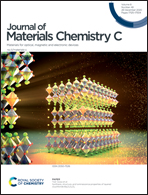Phase transition and multiferroic properties of Zr-doped BiFeO3 thin films
Abstract
BiFe1−xZrxO3 (x = 0, 3, 6, 9, 12 mol%) (BFZrO) films were prepared via the sol–gel method by applying ITO/glass as substrates. The influence of different Zr doping amounts on the crystal structure, oxygen vacancy content, leakage mechanism and optical, ferromagnetic, ferroelectric and aging properties of the BFZrO films was investigated. XRD and Raman results showed that all the BFZrO (0–12 mol%) films are composed of rhombohedral (R3c space group) and orthorhombic (Pnma space group) phases, and with increasing Zr content, the R3c phase content of the BFZrO films gradually decreases while the Pnma phase content gradually increases. SEM and XPS results showed that Zr doping resulted in smaller and more uniform grains of the BFZrO films, and the oxygen vacancy and Fe2+ contents decreased. Zr doping reduced the leakage current density, increased the band gap, improved the ferromagnetic property and degraded the ferroelectric property of the BFZrO thin films. The changes in the above properties are explained from the perspectives of the changes in the two-phase contents, oxygen vacancy concentration, grain size and so on. Due to the aging being related to the oxygen vacancy concentration and the rearrangement of the defect dipoles, the aging degree of BFO films was significantly reduced by Zr doping.



 Please wait while we load your content...
Please wait while we load your content...